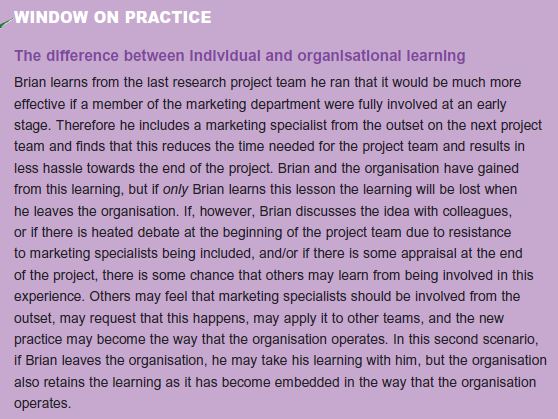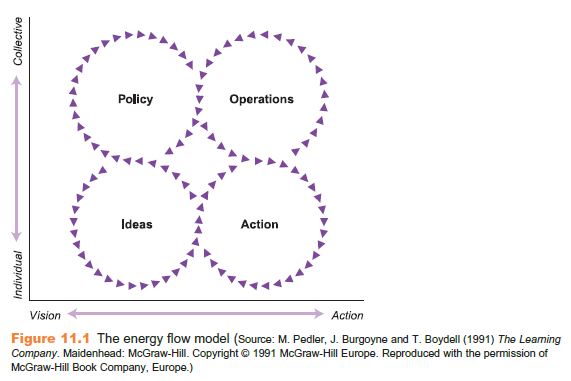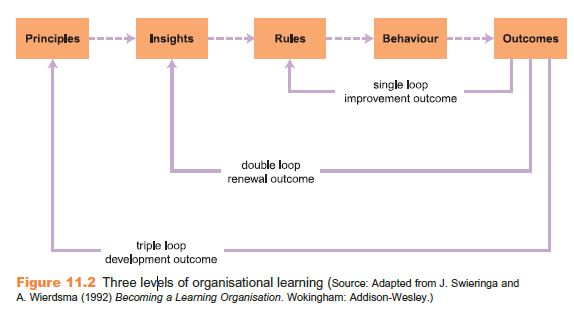Learning Organization
Competitive nature is what aroused the interest level of various organizations. This is because companies know the real aspect of surviving in this competitive market which is in the form of attaining information and inculcate learning. As per the words of Moingeon and Edmonson (1998, p. 9):
It has been quite some time that organizational learning and its concept has been well explored by experts. In addition to their result, its current aspect highlighted the presence of literary facet in it. This finding has been recorded in the late 80s. Again, as per a suggestion in 1989, Pedler gave away another assumption regarding learning organisation. He stated that this is a poor retaliation that can lower the performance level of a company.
He also made another statement on this.
‘Developing the Learning Company’ was a project which was carried out by Burgoyne, Boydell, and Pedler in 1987. With the help of this project, all 3 of them interviewed every company staff member who was pursuing informative strategies regarding learning company.
Their key question to the employees was simple–what were the reasons for which such strategies were sanctioned? It was with the collected answers they found the solutions related to adopting any external measures that can enhance the quality of those strategies. Another of the reasons to carry this project was to improves the relationship between customers and staffs. If they are provided the required confidence for active experimentation, they can actually find out new ways to survive in the pressurised competitive market.
All of them gave a completely new meaning to learning organisation where its expression was not completely reliant on present practices but on ‘dreams’ too. Its representation is,
Smallempirical evidence did come to light in the year 2003 which stated about self-transformation of companies. However, before this, in 1999, conceptualization about learning organisation was terminally dropped. This statement was given by Sloman where he gave the reason of its declining aspect to be entirely dependent on its concept. His assumption was based on the notes of Stewart where he stated learning organisation to have a fault intangible practices. Due to this, implementation of such practices was not possible.
Lipshitz and Popper with Burgoyne agree to most of this assumption in the context of confusion. Still, as per the findings, Burgoyne also made some statement giving away his opinion (positive) regarding its concept. This is because he believed that interest on both the academic and organisational side could help in development and enhancement of the concept. He said that it was absolutely childish or naïve thinking that concept of a learning organisation is not helpful. As per him, only after analysing and developing this concept can prove to be extremely beneficial to various firms.
He also makes a statement where he thinks that the worth of learning organisation is more of a progressive approach and it can be called both unrealistic and utopian approach to a grand project.
Araujo and Easterby-Smith contributed many producible factors with the different disciplines of learning organisation concepts. However, it has to be kept into consideration that the confusing aspect relies on the perspective of various practices and not that of its fundamental ideologies. It is also a fact that theorists and academicians have their personal thinking related to various aspects of this context, but it is also a true fact that a majority of them support it rather than contradict it.
There are also quite many numbers of companies who believed these facts and had adopted learning organisation to find improvement in their goal achievement. However, it is also to be maintained that in place of the approach to be holistic, it was partial.
Organisational learning & the learning regarding organisation
There are 2 aspects on which the learning of organisational learning is dependent upon:
- Collective learning processes
- An individual’s detached observation
Here its focus and approach are again categorised.
Focus
- Learning processes
- Learning nature
Approach
- Academic
- Critical
Araujo and Easter by-Smith also stated that focus of learning organisations is mainly on bringing creative changes on normative models so that the various processes of learning can be enhanced. Organizations and consultants working together on this research stated that the action is basically dependent on the data that comes from a number of interested parties. The study related to this concept is based on different mechanisms which make this learning technique more substantial.
Lipshitz and Popper on the new prospect gave away a new definition. As per them, organisational learning mechanisms are mainly helpful in collecting, evaluating, recording, distributing and utilising the relevant information in enhancing the performance of the company and its members.
With such advantageousness, there are also many issues regarding this organisational learning that one can see from the model created by Pedler. We will be going through it later in this chapter. For now, we need to understand that Araujo and Easter by-Smith made another statement learning organisation. As per them, the highly focused area of a learning organisation is its literary objectives. Itis based on this aspect that the concept mainly relies on. This belief of them is based on the suggestion made by Schon and Argyrisin the year 1996 highlighting lack in critical research work.
Organizational and individual learning
As per some of the definitions related to organisational learning, its expression is mainly focused on 3aspects.
- Self-development
- Learning support
- Individual learning
However, it is imperative to understand that it is more than what these 3 aspects in collective form is. It is only after the learning of a person can he or she interrelate the details. And after achieving this initiative can he final results be achieved. It is through this process can the collective competence be achieved and enhanced. Its resultant will be far more better than what can be achieved individually.
Schon and Argyris consider this a better version regarding utilisation of ‘theory’ and not depending on ‘espoused theory.’ where the former states what requires to be done, the latter refers to what is said on getting the work done.
This can also be explained taking the reference of the unspoken rules of a company that changes with declaring about it. Here the main question is what is the reaction or thought on this in an individual’s mind. Is this change bringing any benefit to them? Does it enhance their learning? What does an individual feel regarding this transformation or change?
Here a huge help can be gained if you don’t consider a corporation to be an entity, rather consider it to be more of a procedure. Pedler explained more about it with the help of a model related to energy flow of a company.
Again different loops or levels related to organisational learning is explained by Schon and Argyris focusing more on its developed side.
As you can see here are 3 main levels.
The first level talks about single loop learning. This can be seen more at the operational level of a company related to the rules level. It is focused more on how an individual can fare better than what they are doing at present.
The second level is about double loop learning. This knowledge development level is more concentrated on comprehension of strategic changes, any possible renewals, and its insight. This is considered the fundamental level which answers to the reasons of the doings of organisational leanings.
The final level talks about triple loop learning. This is the most challenging level which answers the future prospects. It is highlighted mainly on the principles or purposes of a company.
Later you will see the same in figure 11.2.
What are the characteristics of learning organisations?
If you want to understand the various features of a learning organisation then there are a number of approaches dedicated to it. Amongst those, there are 3 key tactics. Th enumero uno approach is given by Pedler who gave away his concept with the help of 11 features.
Looking in
If you look at this theme, you will find 4 features.
- Informating
This mainly comprises of usage of technological aspects. Apart from this, it also focuses on providing information to workers and empowering them. This basically helps you to get a grip on the operations taking place inside a corporation. With the collected information, an individual can learn more about the form and use the details to give away awards, penalise, and take control of both the aspects.
- Control and formative accounting
Under this feature, you can create systems dedicated to reporting, budgeting, and accounting.
- Internal exchange
In this case, you will find all the company’s internal working together and sync. The mentality behind this working procedure is mainly on seeing each other as suppliers and consumers of each other.
- Reward flexibility
This gives answers to the query that why few units receive an extra amount than the rest of the unit working in the same company.
Strategy
There are 2 features that are suggested in a single theme.
#1.
Participative policy making
This expresses that every detail are dispensed in the company. In fact, it also highlights a fact that this info distribution should be shared with the total community, involving customers and suppliers. The main idea through it is participative process revelation and providing satisfaction to the customers. This is seen in the form of productive tensions.
#2.
The second feature is ‘learning approach to strategy’ where 4 aspects are taken into consideration.
- Development
- Assessment
- Application
- Strategy development
These are made on purpose with the help of feedback loop.
Learning opportunities
To avail opportunities, it is important that a learning climate is present. This is the main reason which helps in actions, attitudes and ideas and then promotes its collaboration to be used as an experiment.It is a fact that not all ideas will become successful. So it is important that one should not stop because of mistakes. If those mistakes are rectified on time, one can find out new ways of improving their experimentation’s.
Another side of opportunities is related to self-development which focuses more on facilities and resources. Here employees themselves develop intrinsic levels like:
- Feedback
- Counseling
- Peer support
- Mentoring
- Coaching
During 1990, Peter Senge highlighted practice related perspective. Its explanation was given in 5 dimensions.
- Team learning
One of the important parts of a company, teams can be relayed as a place where one can find various ideas and perspective combining to produce a positive result.
- Personal mastery
It highlights the consistent requirement of self-development (individual).
- Shared visions
It highlights the common requirement needed by the members working in a company – vision to inspire operation by tackling mistrust and various barriers. With its help, one can have an idea of the current state and how it can influence in bringing change in company operation and learning.
- Systems thinking
It showcases correlation between various processes operating inside a company.
- Mental models
It highlights about the requirement related to theory exposure. This is mainly focused on challenging and defying all the odds that arises in a company.
With all these 5 aspects, Peter Senge accepts the positive vision of recognising and attaining leadership roles. He again explains 3 key roles.
- Steward
- Teacher
- Designer
Even if these are in descending order, let us know the details in ascending order. With the role of designer, a leader idealises a vision and engages all the employees to achieve it. Here the work distribution is given as per ability.
With the role of a teacher, a leader imparts necessary information related to the company so that the employees have a deeper insight of their organisation. He or she also provides facilities, gives adequate coaching and guides them to achieve the target.
As per the 3rd role, a leader accepts and fulfils all the responsibility to reach the goal and achieve the mission of the company.
Another of the experts, Bob Garratt,highlighted directorial goals that can help in overcoming the obstacles in learning organisation.
- The team with more power basically tackles all operational problems and focuses on the various strategies to achieve it.
- In case any changes are necessary for the higher level team, extra time is required for that
- To create such team, necessary deployment and employment is a must in case of member strength
- Operation staff and problem solving staff work with each other
- It is imperative that learning is accepted by every employee working at different operational levels in a company
This clearly explains that one cannot expect that a long term strategy can be created within a day.
There are few important points that are highlighted by Easter by-Smith. Those mainly revolve around pointers like rewards, people, details and flexible structures. In the former part of this chapter, we have already seen few of the aspect details. But now we will be discussing about strategies which are also seen as a major problem. Taking candidate employment in focus, sometimes it becomes important to select someone who does not have higher chances of fitting into the job profile. In most cases, such types of candidates are flexible and open to adapting.
Critique
Idealism in the initial level is highly pragmatic and has more scope for development. There are mainly 4 important situations that Lipshitz and Popper have recognized in 2000 regarding productive organisational learning.
- Accountability
This highlights taking responsibility for the actions that an individual takes and is ready to bear the consequences.
- Not personal orientation but issues orientation
This showcases the fact that judgment of any detail is based on relevant issues and merits. It has to be considered that it is about information and not individual characteristics.
- Transparency
This highlights open to inspection attribute that is well received via feedback. This saves information distortion, excessive pressure and self-deception.
- Valid information
This focuses on valid, undistorted, and complete details.
When we go through Burgoyne’s approaches, we will be reading about 9 factors that are responsible for consistent learning organisation.
There are certain notes by Hawkins that campaigns eagerness related to TQM (total quality management) and learning organisations. As per his assumption, learning value states about the goal of the objectives whereas learning relates the details that are learned. It is important that learning should not consider as a completion but a vessel to reach the goal of gaining completion. This is based on the activity suitable for it. This relays the fact that there isn’t any solid evidence for it.
It is also a fact that one cannot consider literature to be a shield.
In 2003, Sun and Scott produced their suggestions regarding implementation issues. As per their provided information, an individual requires comprehending the details of learning and then use it for company development.
In the current knowledge management scenario, it has been seen that the approach is more or less applicable or practical. Still, we have more suggestions related to learning organisation.
Links of Previous Main Topic:-
- Contractors and their contracts with consultants
- Recruitment
- Selection methods and decisions
- Staff retention
- Ending the contract
- Strategic aspects of performance
- Organisational performance
- Organisational performance initiatives
Links of Next HR Management Topics:-











